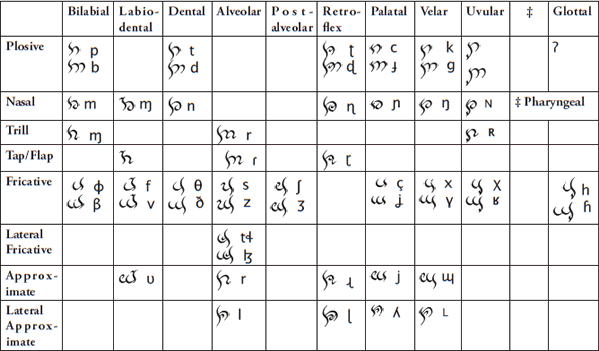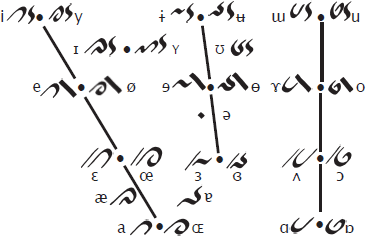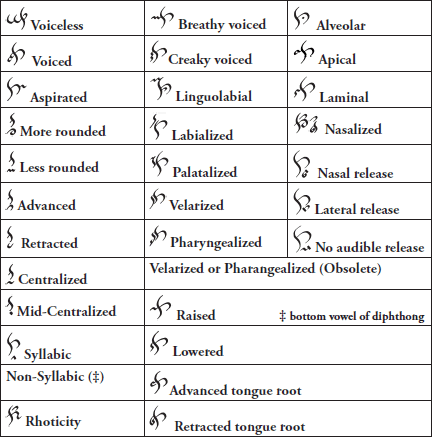
Phon is a universal auxiliary writing system invented by Samuel Putman. Universal because, like the International Phonetic Alphabet, Phon can be used in principle to write any statement in any language. Auxiliary because, like Esperanto, Phon is not designed to replace existing natural scripts, but rather to offer a way for all peoples of the world to write, precisely, the statements they wish to make.
Therefore, Phon is featural, representing sounds by the shapes of the individual glyphs. Featural writing systems have been designed before, and Phon owes a debt to these. In particular, it can be considered a descendant of the Tengwar, although it uses the basic scheme in a different manner. Consonants are composed of a stem (the sirpe) which shows the locations where the sound is articulated, and a leaf (lasse) showing place of articulation. Vowels also have a rational form, and can be placed above or below the lasse of a consonant, or over a bare sirpe to represent dipthongs and isolated vowels.
Furthermore, Phon is designed so that every stroke, and hence every character, exhibits asymmetry over the vertical axis. That is to say, no characters take the form of the letter 'w', which is symmetrical a cross its own axis, and no characters take the forms of the lowercase letters 'b' and 'd', which are mirrors of each other across this axis. As a result, Phon can be written and understood in either direction, and with either hand, without changing the shapes of the strokes.





All human beings are born free and equal in dignity and rights. They
are endowed with reason and conscience and should act towards one another
in a spirit of brotherhood.
(Article 1 of the Universal Declaration of Human Rights)
Phon Book - more details of the Phon alphabet (PDF, 2MB)
If you have any questions about Phon alphabet, you can contact Samuel at: atmanistan@gmail.com
Constructed scripts for: Ainu | Arabic | Chinese languages | Dutch | English | Hawaiian | Hungarian | Japanese | Korean | Lingala | Malay & Indonesian | Persian | Tagalog / Filipino | Russian | Sanskrit | Spanish | Taino | Turkish | Vietnamese | Welsh | Other natural languages | Colour-based scripts | Tactile scripts | Phonetic/universal scripts | Constructed scripts for constructed languages | Adaptations of existing alphabets | Fictional alphabets | Magical alphabets | A-Z index | How to submit a constructed script
[top]
You can support this site by Buying Me A Coffee, and if you like what you see on this page, you can use the buttons below to share it with people you know.

If you like this site and find it useful, you can support it by making a donation via PayPal or Patreon, or by contributing in other ways. Omniglot is how I make my living.
Note: all links on this site to Amazon.com, Amazon.co.uk
and Amazon.fr
are affiliate links. This means I earn a commission if you click on any of them and buy something. So by clicking on these links you can help to support this site.
[top]